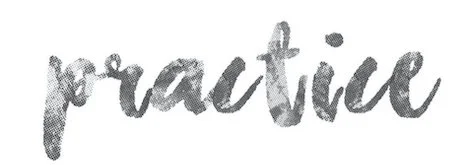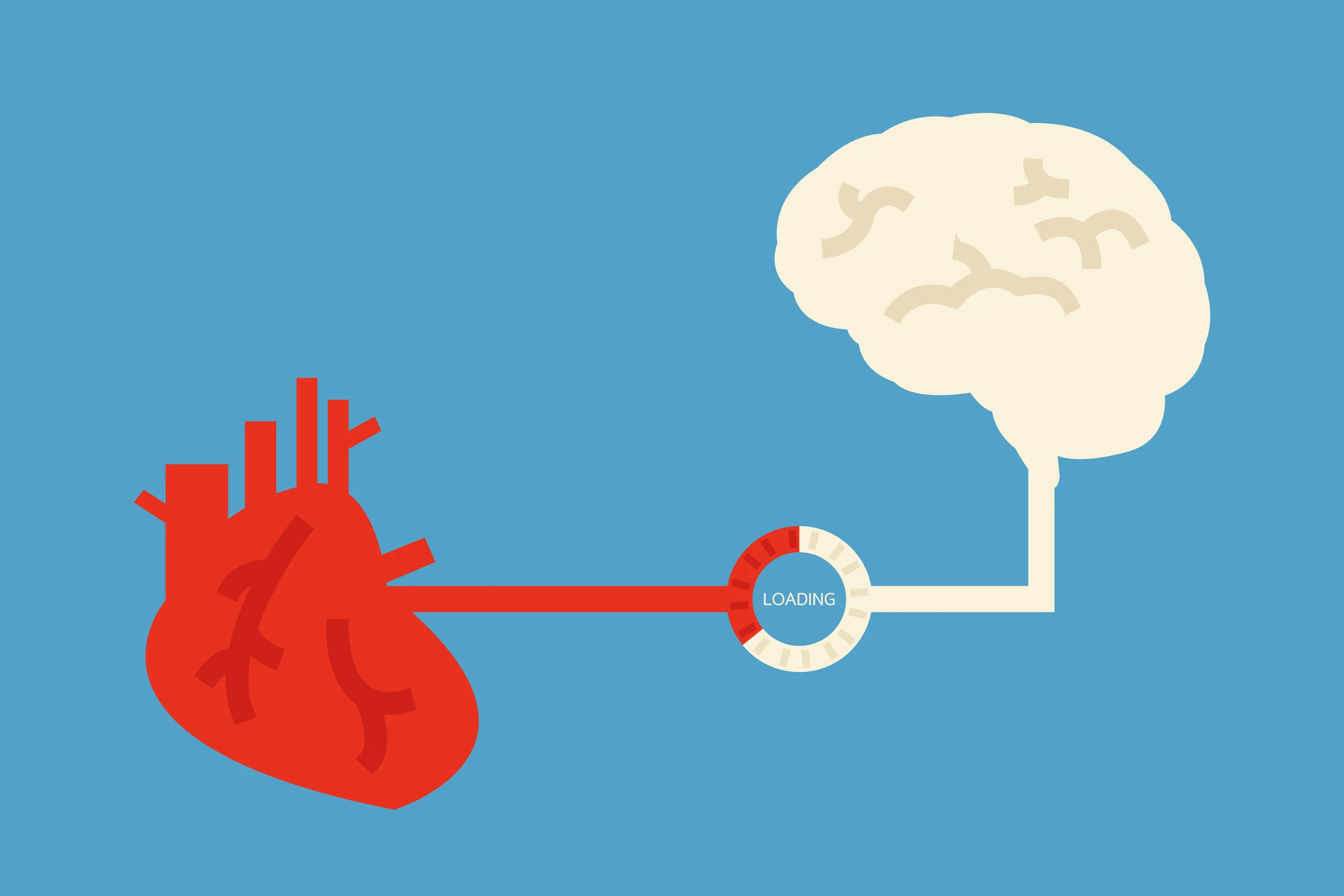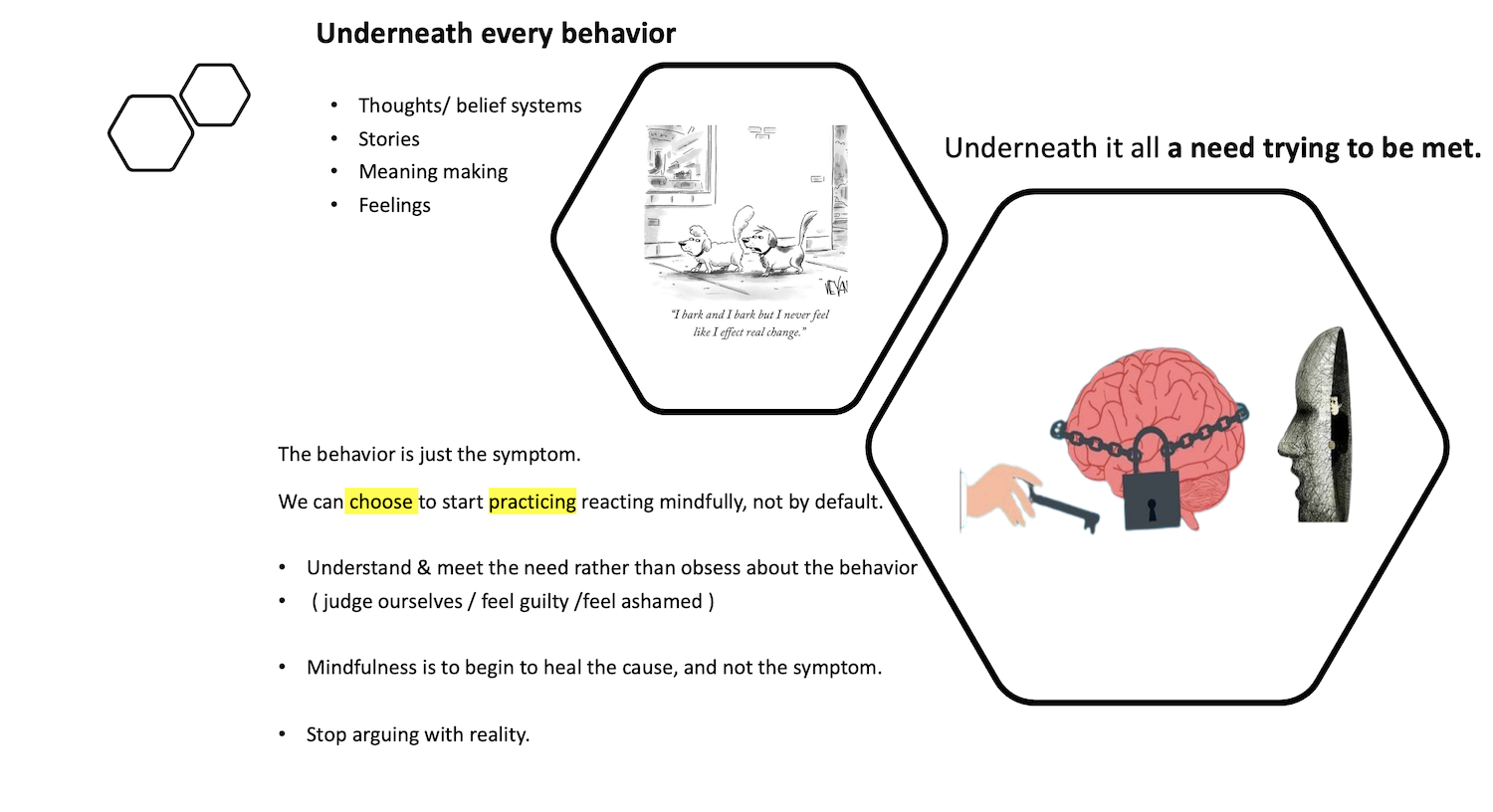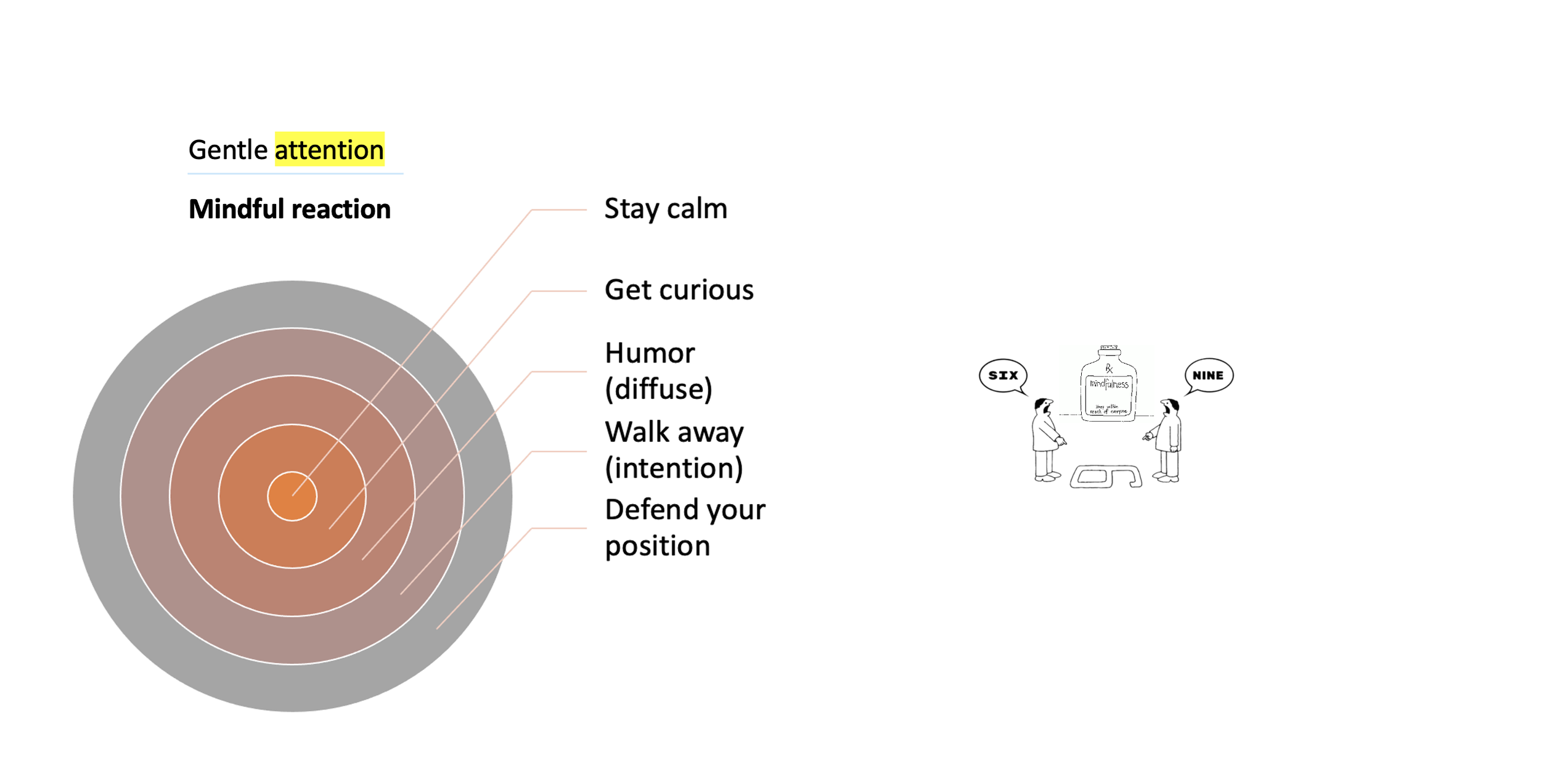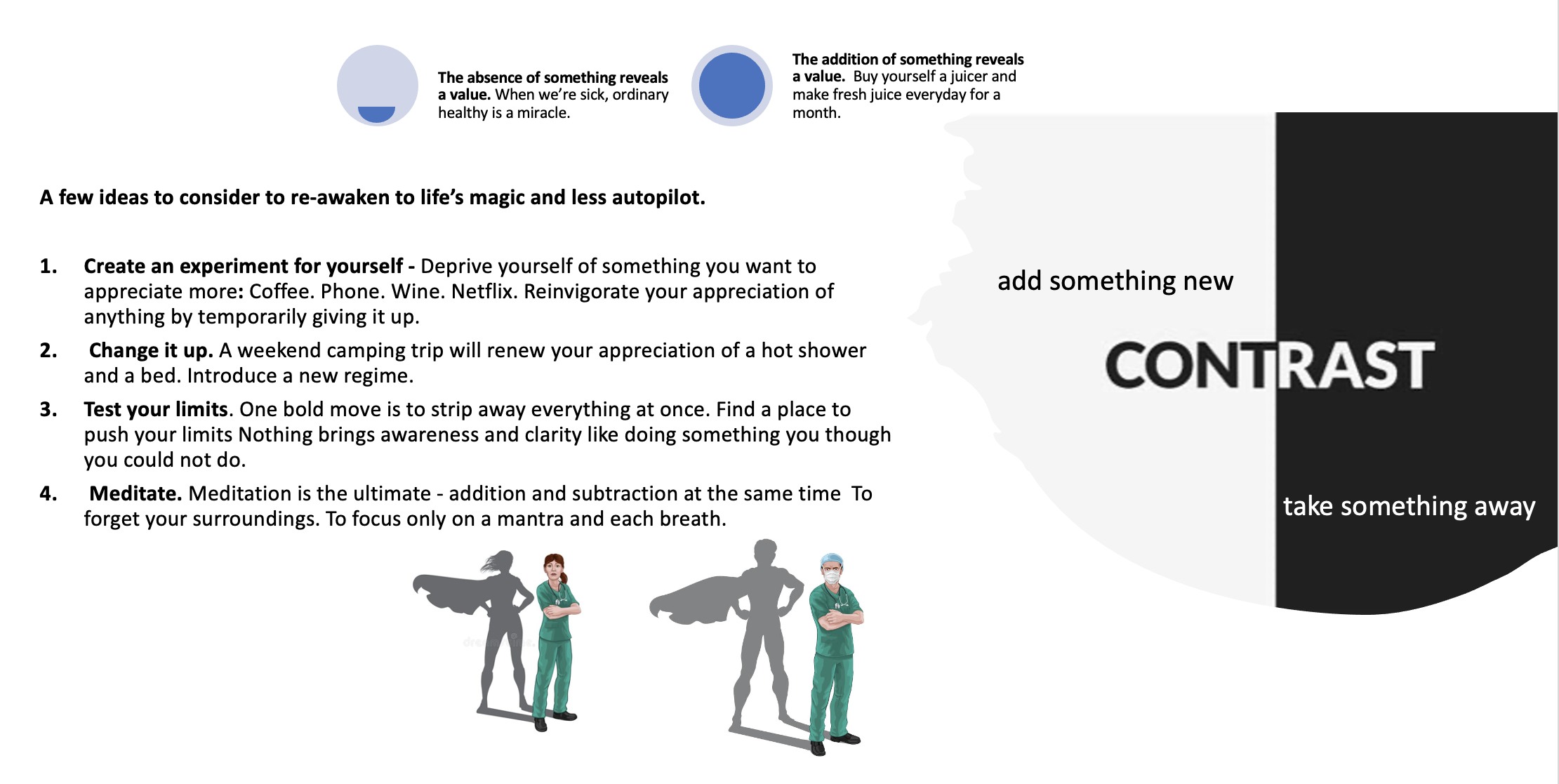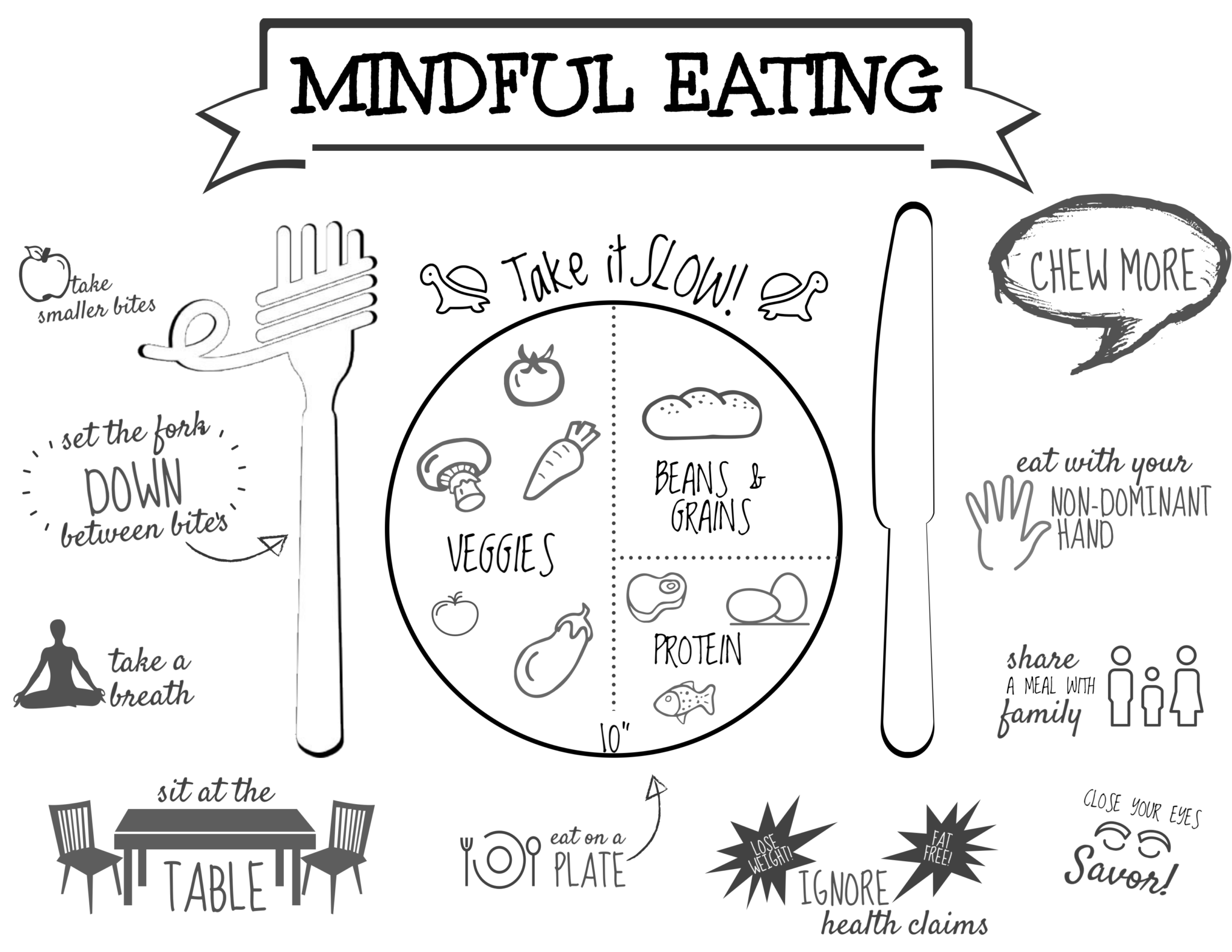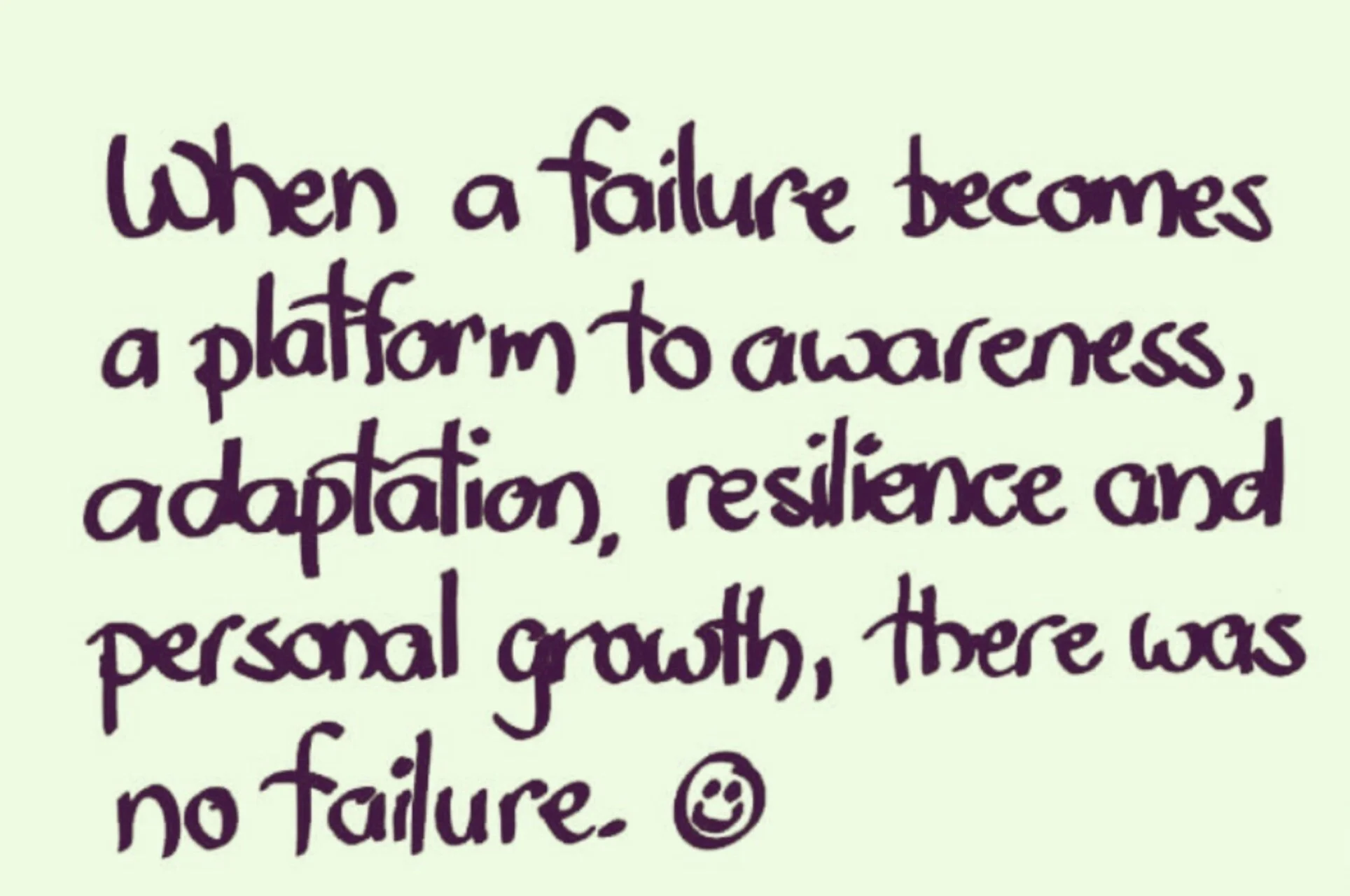
Microdosing Mindfulness
You are the medicine
AUTOPILOT
Autopilot
Class Two
By David Frank Gomes
Welcome to our exploration of mindfulness. Please reach out if you have questions about your practice.
If you missed the recording of our zoom class, you can watch the recording.
AUTO-PILOT LIVING
Autopilot living involves a behaviour occurring outside of conscious awareness when we are not consciously aware of our behaviour.
Although it may be difficult to imagine, some researchers believe that 90% of our behaviour is carried out automatically.
A clear example of automatic behaviour is driving a car. If you are an experienced driver, you will likely not be aware of the process of changing gears, the movement of your feet while doing so, and the way you hold the steering wheel.
Automatic patterns develop through repetition. By repeating a certain action, it gradually becomes automatic, thereby reducing the need for conscious attention.
Automatic patterns are not limited to behaviour, like driving a car or playing the piano.
Thought patterns or coping with setbacks or stress can also become automatic. Although in some cases, automatic behaviour is very useful, it can also cause serious problems.
Certain feelings, thoughts, or sensations can automatically lead to a reaction, like suppression or worry, for instance. In these situations, we are not in conscious control of the reaction. The reaction is the result of an unconscious tendency. This way of dealing with situations is referred to as impulsivity or reactivity.
HOW WE PAY ATTENTION
The two neural networks we tune into.
People have two distinct ways of paying attention to the world around them and the world inside them, engaging two different sets of neural networks - default and mindful.
The default network is processing imaginary things, daydreaming, planning the future or retrieving memories. This network contains stories, analyses, memories, and interpretations of situations.
Life can get highly dominated by this channel. If we tune in too often it leaves little space to experience reality for what it is without stories and interpretations.
It takes you out of the present moment because you are not there, you are in an imaginary story.
We’ll call this “ LOST IN THOUGHT” CHANEL
The mindful network is just being where you are and doing what needs to be done in the moment as it is happening.
We’ll call this the HERE AND NOW CHANNEL.
What station are you tuned into?
Start noticing what channel you are tuned into.
The default mode network becomes active when we stop paying attention.
1. Being more aware of ordinary moments and bringing gentle attention to them helps you tune into the mindful network.
2. Make a very conscious decision to start paying more attention to what you're doing, and be more thoughtful about why you're doing it.
If I’m feeling overstimulated, my antidote might be different than if I’m feeling bored and zoning out.
Over time small changes can lead to major shifts, not just in what you are 'doing', but in who you are 'being' as you do it.
Is it time to decide to live more purposefully, more intentionally, more mindfully? By design, not by default?
Becoming aware of automatic patterns is at the core of many psychological treatments, for instance, cognitive-behavioural therapy. As already pointed out in session 1, wise attention is a central aspect of mindfulness.
This attention can be used to recognize automatic reactions and patterns and begin to transform them.
These patterns can be changed only when they are recognized.
Mindfulness promotes attention to feelings, thoughts, and sensations. In other words, mindfulness promotes the awareness of what is present in the here and now. By paying attention, space is created between what is happening in this moment and the reaction that follows. If we experience an emotion like anger, mindfulness helps us pause for a second and pay attention to the experience.
Mindfulness creates room between a situation and a reaction
By paying attention to the emotion and staying connected to the experience, the chance of reacting impulsively is reduced. Thus, instead of automatically reacting aggressively (for instance by raising your voice at another person), we direct attention to our own emotional experience, through consciousness.
Ultimately, a conscious choice rather than an automatic response will guide the reaction that follows
Mindfulness helps reduce automatic pilot responding. It’s like the emergency break.
AUTOMATIC BEHAVIOR
Mindful Awareness & your brain on autopilot
When we are in a state of complete mindful awareness to the present moment, it is the complete opposite of being on autopilot. Examples of being conscious of the present moment versus going through the motions:
Instead of being distracted by each incoming stimuli, you have a conscious intention to direct your focus to a chosen person/object/thought.
Instead of your attention being completely taken by thoughts and concepts, you are open to experiencing the direct felt sensory experience of the present moment.
Instead of analyzing and judging whatever is currently happening, you have an attitude of openness and acceptance of the unfolding moment.
When we are on automatic pilot, we are unaware and out of touch with the present moment; our conscious awareness is clouded. While there are numerous benefits to be able to go on autopilot (e.g., performing tasks, problem-solving, retrieving memories, planning for the future and daydreaming ), autopilot becomes harmful when it applies to our emotional experience and numbing ourselves out in daily life.
Consider the ways in which you can use your innate ability to go on automatic pilot in ways that are beneficial to you and in your best interest.
Now reflect on the ways in which the tendency to go on autopilot is harmful to your felt emotional experience.
How can you choose to be more present emotionally while simultaneously allowing yourself to use autopilot to help you engage in tasks and problem-solving?
If you want to find out if you are living too often on autopilot, try the experiment below.
Try this EXPERIMENT
Set an alarm on your phone for varying times on each day of the following week (ideally three alarms a day at different times on each day).
Every time the alarm rings, see what you are doing at that moment and note it down right away (or later, if you cannot do it immediately).
Ask yourself if that is something that you want or need to do?
If yes, are you doing it properly or with full attention?
Are you doing it simply out of habit or because you thought you should?
Do you know why or for what bigger purpose you are doing it?
Answer these questions honestly.
You might get some interesting clues from this experiment :)
CYCLES OR FEEDBACK LOOPS
Auto pilot can also cause us to get stuck in a negative cycle of feeling and thinking. Fig. 3 depicts an example of such a cycle.
Example of an automatic cycle of thinking and feeling
Imagine you receive a bad evaluation (situation). An immediate result of this news is a feeling of sadness or frustration (feeling or emotion). Often, we automatically start thinking.
Our thoughts may concern the feeling (“this is no good, I don’t want this, this must stop”) or the situation (“how could this ever happen?”) or the self (“maybe I am just not good enough”). These thoughts can cause feelings or emotions that can trigger further negative thoughts, etc.
It is also possible that the bad evaluation first triggers thoughts (“This can’t be true,” “I am a failure”) that produce negative emotions, like embarrassment or frustration, which then trigger new thoughts, and so on.
Regardless of what is triggered first (thoughts or emotions) by a situation, when we are not aware of this automatic interplay between thoughts and emotions, we can get caught in a cycle of thinking and feeling for a very long time. Because we are paying so much attention to our thoughts, we lose awareness of what is happening; instead, we are caught in a game of feelings and thoughts which often leads to excessive worrying or ruminating (repetitive and negative thinking about the past).
The situation depicted shows how we can get completely lost in a train of thought. We are devoting so much attention to our thoughts that we lose ourselves completely in them. All our attention goes to the content of our thoughts. We are not present in the now anymore; instead, we are living a life that is played out in our head. Our thoughts determine automatically our feelings.
We become slaves to our thoughts and barely notice how we shift between thoughts and feelings and how they create behaviours we don't want.
Even if we notice that the cycle is taking place, we often use strategies (like suppression) that not only fail to get us out of the cycle but pull us back in it.
From a rational point of view, these strategies appear to be effective in helping individuals get out of the cycle.
However, the more we attempt to avoid or get rid of the thoughts and feelings, the more they persist.
Imagine strolling along a street that you are well-acquainted with. As you look up, you notice that there is someone you know on the other side of the road. You smile and wave, however, the person does not respond. The person continues to walk without giving you the slightest reaction.
As you were imagining, did you notice any of your thoughts?
As you were imagining, did you notice any of your emotions?
Thoughts often emerge immediately and automatically…the mind produces stories…these stories are often not true but they lead to emotions and you are again in a feedback loop, as you can see in the illustration below.
“The simple act of paying gentle attention can take you a long long way in life.”
ATTENTION TO THE HERE AND NOW
By paying attention to the thoughts and feelings that are present in the current moment, we can disrupt the cycle and create room for awareness.
This awareness allows us to observe the cycle between thoughts and emotions. For instance, if you receive a bad evaluation that automatically triggers negative thoughts, mindfulness involves taking a step back and noticing these thoughts.
Hence, it becomes important to pause for a moment and focus on breathing.
Then become aware of what is going on inside of you.
What thoughts are currently running through your mind?
What kind of feelings are present in this moment?
Where in your body do you notice these feelings?
What is the underlying need you are trying to satisfy?
By taking the role of a neutral and curious observer, the automatic cycle of thinking and feeling is disrupted. If you notice that you are not observing anymore but that your thoughts or feelings are taking you away again, simply focus on your breathing once more and use this neutral point to take the role of an observer again.
Note that you are not trying to change the emotions or feelings that are present, but rather, you are trying to observe and accept what you experience.
By turning attention back to the present moment, you create room and insight. Thus, mindfulness can help you become aware of the automatic influence of thoughts on emotions and vice versa.
Take the case of Mr. 6 and Mr. 9 having an argument below. As in many arguments, they both appear to be right.
The first step is always to try to pause and breathe and anchor yourself.
Bring gentle awareness to the situation to try and understand how you are feeling in the moment. Then you can more likely choose to make a mindful choice as to how you will react.
Then you can choose what mindful action you will take.
Thoughts and emotions are not changed or modified; instead, the way in which you relate to these emotions and thoughts is altered. Feelings are less guided by thoughts, and you become more like an observer.
In this observer mode, your thoughts no longer dictate your feelings and your actions. They become part of a mindful container.
IS LIFE FEELING TOO PREDICTABLE ?
Try adding some contrast.
Do you find yourself eating the same thing, saying the same thing, and going through the same routine day-to-day?
Do you go days, weeks, or months without taking time for yourself?
Have you lost track of your dreams, goals, and future plans?
Do you often find yourself saying, “I don’t have time for ”?”
Do you make choices and decisions that you later regret because you didn’t think them through?
Are you ignoring those things in life that aren’t going well because you “can’t deal with it right now?”
You may need to shake things up from time to time, and create some new contrast in your life.
““ YOUR LIFE is not a journey you want to make on autopilot.””
Thank you.
AT-HOME PRACTICE FOR WEEK TWO
THE BODY SCAN
The body scan teaches us to recognize and experience physical sensations. Much of our attention focuses on our thoughts and matters outside our body, such as our job, social environment, etc. This increases the risk that one will pay very little attention to physical signals. The recognition of physical signals, such as tension or restlessness, is important, especially for the prevention of stress and burn-out. The body scan is a method used to get more in touch with body sensations and signals and to become familiar with them.
The body scan allows us to experience the noise of our thoughts through our bodies. The simple instruction binds attention to one part of the body at a time, which can be much more difficult than one might initially think.
The body scan teaches us to draw attention to a specific point. In the body scan, the point of attention is one part of the body. The effect of such training of attention can also transfer to other areas, such as focusing (concentrating) the attention on a specific task, a conversation with someone, etc.
The body scan method teaches us to detect when attention wanders. Being able to notice when attention wanders is a critical component of successful self-control. The self-control literature uses the term “monitoring” to describe this function.
The body scan can provide insight into the nature and pattern of thoughts in general. This would allow you to notice recurring themes of thoughts that are played repeatedly like an old record.
The body scan teaches us to cultivate self-compassion. Rather than criticizing ourselves for being distracted, attention is returned to the body, gently without judgment.
EXERCISE: THE BODY SCAN
The body scan, as the name suggests, entails bringing awareness to each part of the body, starting with the feet and moving up from there.
Tips for the body scan:
1. During the body scan: meditation, you may get distracted, fall asleep, find your mind wandering, and/or feel body sensations. Consider that it is a part of and a challenge of the exercise. That's ok.
2. The moment you realize that you are not present in the exercise, you are in fact already present. Simply realizing that you are not present is a success, and the non-presence makes success possible.
3. If your mind wanders a lot, consider these thoughts as passing events, nothing special). Then try to gently bring your attention back to the body scan in the present moment.
4. Try not to focus on ideas such as “success”, “failure”, “doing really well”, or “trying to relax the body.” The body scan is not a competition; it is not a skill to be achieved. The only thing that is important and that really helps is practice.
5. Try to approach your experience with an accepting attitude, or in other words, allow it to just happen, “that’s just how it is right here, right now.” If you try to avoid, suppress, or expel unpleasant thoughts, feelings, or physical sensations, chances are high that they will just return more often.
KEY POINTS
· Find a place where you will be safe, secure, and undisturbed.
· Lie on your back, on a firm mat or cushioned floor, arms resting by your side, palms facing upward.
· If you find yourself having a hard time staying awake during the scan, it may be helpful to open your eyes or prop your head up with a pillow. If neither helps, you have the option to move into another position that will allow for wakefulness. Other positions include standing or seated in a chair.
· Let your eyes close and start to focus your attention on the fact that you are breathing. Allow each inhale and exhale to flow through your body. Notice how your body feels with each breath as well as where the breath flows. With each breath, allow yourself to sink deeper into the floor.
· Keep in mind that your mind will inevitably wander through this practice as that is what all minds do. When this happens, notice it, and gently and kindly bring your attention back to the part of the body that you were focusing on.
You can listen or download the guided version to get the idea of how to do this practice. You can also make it shorter, and do it in your own way. The point is to check in with your body daily.
2. ROUTINE ACTIVITIES
Perhaps this week you might use a piece of fruit such as an orange and practice being totally aware of what you are doing as you peel it and eat it slowly and with full mindful attention. In other words, try to focus on the act just without thinking about anything else. During the next week, choose routine activities on which you will consciously focus your attention.
These informal practices give you the chance to practise paying attention in a particular way without the extra burden of ‘finding time to be mindful’. Mindfulness does not require extra time.
And you are firing up the mindful network.
PRACTICE: EATING WITH AWARENESS
Start with becoming aware of your posture. Close your eyes for a few seconds and focus on breathing. Now, open your eyes, but wait before taking the first bite. Look at the food, the colour, and the texture. Just become aware of what is in front of you. You can also briefly consider the amount of work necessary to make this food possible.
Then take a first bite. Eat slowly, one bite at a time, prolonging the sensation of the food in your mouth and on your tongue.
Try to become aware of the taste, the movement of the fork, and the whole eating process as much as possible. Thoughts will come up and will distract you.
This is normal.
Just notice them and gently direct your attention back to the food. It is easier to eat mindfully without external distractions, such as television, magazines, and the like. Make eating the meal the most important activity. Devote all your attention to it.
Eating is a daily habit that involves many automatic processes. Eating does not always require focused attention. We can easily have dinner and watch television, send an email, or have a conversation at the same time. When we do so, we become less aware of the process of eating and tasting the food. Our attention is not focused on the sensation of eating but on the television, email, or the content of the conversation. When this happens, we tend to enjoy the food less.
During the body scan, a certain body part becomes the anchor of our attention. If we practice mindful eating, what we experience while we eat (e.g., the taste, smell, and texture of the food) becomes the anchor of our attention. When you eat mindfully, you will notice how many times your attention is drawn away from eating by thoughts or other distractors. The idea is to gently direct attention back to the anchor, the experience of eating.
This exercise can show you that even when your attention should be focused on eating the food in the present when you take a bite and before you even swallow, your mind is already focusing on the next bite.
This is a pattern that is often present when eating candy, chips, or other comfort food.
3. SO HUM MEDITATION -
SO HUM MEDITATION - Basic Guidelines
Consistency Is Good
Particularly when you’re just beginning, it’s useful to have a schedule and structure that you commit to. So, for example, decide that you’re going to practice meditation 5 times a week. Each session will be for 5 minutes, from 7:00 to 7:05 a.m. Maintain this schedule for this week and see how it feels, and then re-evaluate if you need to.
Practice before a meal rather than after
Most people feel a little drowsy immediately following a meal. The body is in its “rest and digest” mode, so it’s best to allow it to do those things. Meditating immediately before a meal is a beautiful way of tuning in to the energy of mindfulness. You may notice that food tastes better after meditating than it does otherwise because of your heightened awareness.
Meditation is the art of starting over
Again and again, you’ll notice yourself being distracted during your meditation. This is not a problem. Noticing your distraction is the “magic moment” when you’re invited to start over—to knowingly reconnect with awareness.
Relaxing your jaw completely and saying “ahh” can help you let go of whatever concept, belief, or emotional upheaval you were caught in. Just allow it to pass and come back to the here and now. Each moment is fresh and new, infinitely rich and mysterious. What is it revealing? Welcome it fully.
Being upright
Whether you’re sitting on the floor or in a chair, allow your spine to be in its naturally upright position. In this position, your body will feel relaxed and expanded. Also, bring your attitude into an upright position. In other words, let your mind be open and alert, cultivate a sense of confidence and curiosity, and know that you’re doing something excellent for yourself.
Creating Your Own Peaceful Retreat
Your environment can be supportive of your meditation practice. You may find that these added measures help you follow through on your intention to meditate.
Here are some ideas:
AT HOME
If possible, practice in a relatively quiet and uncluttered space that is used only for meditation. It does not have to be a separate room; a corner of a room will do. You may wish, if you like to create some kind of alter for yourself.
An alter is a way of focusing your attention and practice. On it you might have a vase of flowers and a beeswax candle, which you light before your session.
You might have pictures of loved ones or teachers or sacred objects that mean something to you.
We are trying to create a space of peacefulness, and beauty, supportive of the internal qualities you wish to cultivate. You may like to use a round meditation cushion (zafu), a low-to-ground meditation bench (seiza bench), and/or a flat, square meditation pad (zabuton) to make sitting more comfortable.
You may also sit on a folded blanket or in a straight-backed chair or even on your bed if that is the only place available to you. Just try and find a way to be as comfortable as possible with your spine straight.
SO HUM SEATED MANTRA MEDITATION
Translated from Sanskrit, this mantra means “I am that.” “I am that” is a complete sentence.
This mantra is great for getting grounded, and connecting with your “enoughness.”
Think of it as an affirmation that you are here now, exactly where you are supposed to be, and you are creative, resourceful and whole, just as you are.
You are safe. You are becoming. You are enough.
INSTRUCTIONS
Close your eyes and gently look upward, focusing the gaze and the attention as though looking out through a point between the eyebrows. (A person deep in concentration often "knits" his brows at this spot.) Do not cross the eyes or strain them; the upward gaze comes naturally when one is relaxed and calmly concentrated.
As you inhale, silently repeat the word “So“
As you exhale, silently repeat the word “Hum“
Don’t try to control your breath, just observe it as if you are watching someone else breathing.
When it wants to go in, silently repeat the word “So“
When it wants to go out silently repeat the word “HUM“
Each time you notice your mind wander, simply draw your attention back to your silent mantra and begin again.
Practice for 1 - 5 minutes or more in the morning and in the evening if possible.
JOURNALING (OPTIONAL)
Journaling is a powerful tool for self-reflection, awareness, and improvement. It will help you identify and understand your thoughts, patterns, beliefs, feelings, and deepest desires. It can connect the dots on how things have gone in your life so far, while also constructing the future of your dreams.
Most importantly, it can be a safe space for you to freely express what’s on your mind and get it all out! Because we spend so much of our day on autopilot, it means we never really get the chance to acknowledge our thoughts and emotions, especially the negative ones that keep us stuck. The longer we go with those thoughts and emotions swirling around in our minds, the more stuck we become!
Channel your inner “JOURNALER”
Journaling - is a place to be your true self—to have bad days and let it out, to have good days and celebrate, to express hopes and dreams, to acknowledge fears and doubts—all without judgment.
All this to say, if you’re “not a journal person” or feel skeptical, I encourage you to give it an honest try anyway. Just grab that notepad out of the drawer or some blank printer paper to start.
Here’s the best part about journaling: You can’t do it wrong! As long as you’re putting pen to paper, you are reaping the benefits.
TIPS
Consider the time you spend journaling, whether it’s 2 minutes or 2 hours, as self-care. Find a quiet corner, get comfy, grab a snack or cup of tea, light a candle, and take a few deep breaths to relax before you begin.
Don’t overthink it! Don’t obsess so much about what you “should” write - a natural stream of consciousness is great. Just start writing anything, and let it flow from there.
Keep your journal a judgment-free zone. Don’t judge yourself for what comes up as you write. This is a safe place for you to freely get out what’s on your mind, no matter what it is or how bad it seems.
Carve out at least 5 minutes to free-write. Free-writing means putting pen to paper and letting whatever comes up flow out onto the page. It’s a method to get the “muck”—the thoughts currently swimming around in your mind—out and onto paper, which often decreases the emotion and stress around those thoughts, putting the mind at ease and allowing calmer, more peaceful thoughts to fill the space.
If this comes naturally for you, great! If you need some cues to get started, follow the prompts below. Be sure to continue your free-writing until you feel complete.
What’s bothering me right now?
What am I curious about these days?
What do I love about life?
What’s causing me stress?
What has been on my mind a lot lately?
What do I want to change about my current situation?
What’s keeping me from feeling completely happy right now?
If you don’t yet have a journal, no problem! Just grab a notepad or some blank sheets of paper to answer the questions above. Extra credit if you invest in a journal today for your future journaling self!
I recommend free-writing anytime you feel like your mind is in constant chatter mode, you’re feeling stressed, or you’re overcome with a negative emotion.
Have fun, and don’t forget to let it all out!
And remember, just do your best. That is enough.
Additional resources and inspiration:
Link to The top 5 regrets of the dying book by Bronnie Ware


